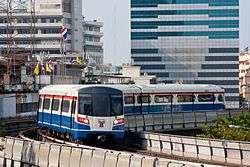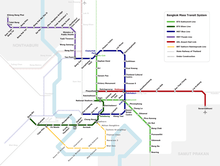BTS Skytrain
 | |||||||||||||||||||||||||||||||||||||||||||||||||||||||||||||||||||||||||||||||||||||||||||||||||||||||||||||||||||||||||||||||||||||||||||||||||||||||||||||||||||||||||||||||||||||||||||||||||||||||||||||||||||||||||||||||||||||||||||||||||||||||||||||||||||||||||||||||||||||||||||||||||||||||||||||||||||||||||||||||||||||||||||||||||||||||||||||||||||||||||||||||||||||||||||||||||||||||||||||||||||||||||||||||||||||||||||||||||||||||||||||||||||||||||||||||||||||||||||||||||||||||||||||||||||||||||||||||||||||||||||||
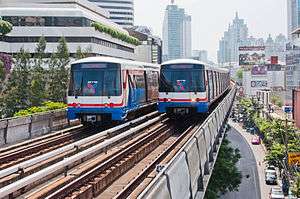 | |||||||||||||||||||||||||||||||||||||||||||||||||||||||||||||||||||||||||||||||||||||||||||||||||||||||||||||||||||||||||||||||||||||||||||||||||||||||||||||||||||||||||||||||||||||||||||||||||||||||||||||||||||||||||||||||||||||||||||||||||||||||||||||||||||||||||||||||||||||||||||||||||||||||||||||||||||||||||||||||||||||||||||||||||||||||||||||||||||||||||||||||||||||||||||||||||||||||||||||||||||||||||||||||||||||||||||||||||||||||||||||||||||||||||||||||||||||||||||||||||||||||||||||||||||||||||||||||||||||||||||||
| Overview | |||||||||||||||||||||||||||||||||||||||||||||||||||||||||||||||||||||||||||||||||||||||||||||||||||||||||||||||||||||||||||||||||||||||||||||||||||||||||||||||||||||||||||||||||||||||||||||||||||||||||||||||||||||||||||||||||||||||||||||||||||||||||||||||||||||||||||||||||||||||||||||||||||||||||||||||||||||||||||||||||||||||||||||||||||||||||||||||||||||||||||||||||||||||||||||||||||||||||||||||||||||||||||||||||||||||||||||||||||||||||||||||||||||||||||||||||||||||||||||||||||||||||||||||||||||||||||||||||||||||||||||
|---|---|---|---|---|---|---|---|---|---|---|---|---|---|---|---|---|---|---|---|---|---|---|---|---|---|---|---|---|---|---|---|---|---|---|---|---|---|---|---|---|---|---|---|---|---|---|---|---|---|---|---|---|---|---|---|---|---|---|---|---|---|---|---|---|---|---|---|---|---|---|---|---|---|---|---|---|---|---|---|---|---|---|---|---|---|---|---|---|---|---|---|---|---|---|---|---|---|---|---|---|---|---|---|---|---|---|---|---|---|---|---|---|---|---|---|---|---|---|---|---|---|---|---|---|---|---|---|---|---|---|---|---|---|---|---|---|---|---|---|---|---|---|---|---|---|---|---|---|---|---|---|---|---|---|---|---|---|---|---|---|---|---|---|---|---|---|---|---|---|---|---|---|---|---|---|---|---|---|---|---|---|---|---|---|---|---|---|---|---|---|---|---|---|---|---|---|---|---|---|---|---|---|---|---|---|---|---|---|---|---|---|---|---|---|---|---|---|---|---|---|---|---|---|---|---|---|---|---|---|---|---|---|---|---|---|---|---|---|---|---|---|---|---|---|---|---|---|---|---|---|---|---|---|---|---|---|---|---|---|---|---|---|---|---|---|---|---|---|---|---|---|---|---|---|---|---|---|---|---|---|---|---|---|---|---|---|---|---|---|---|---|---|---|---|---|---|---|---|---|---|---|---|---|---|---|---|---|---|---|---|---|---|---|---|---|---|---|---|---|---|---|---|---|---|---|---|---|---|---|---|---|---|---|---|---|---|---|---|---|---|---|---|---|---|---|---|---|---|---|---|---|---|---|---|---|---|---|---|---|---|---|---|---|---|---|---|---|---|---|---|---|---|---|---|---|---|---|---|---|---|---|---|---|---|---|---|---|---|---|---|---|---|---|---|---|---|---|---|---|---|---|---|---|---|---|---|---|---|---|---|---|---|---|---|---|---|---|---|---|---|---|---|---|---|---|---|---|---|---|---|---|---|---|---|---|---|---|---|---|---|---|---|---|---|---|---|---|---|---|---|---|---|---|---|---|---|---|---|---|---|---|---|---|---|---|---|---|---|---|---|---|---|---|---|---|---|---|---|---|---|---|---|---|---|---|---|---|---|---|---|---|---|---|---|---|---|---|---|---|---|---|---|---|---|---|---|---|---|---|---|---|---|---|---|---|---|---|---|---|---|---|---|---|---|---|
| Native name | Bangkok Mass Transit System | ||||||||||||||||||||||||||||||||||||||||||||||||||||||||||||||||||||||||||||||||||||||||||||||||||||||||||||||||||||||||||||||||||||||||||||||||||||||||||||||||||||||||||||||||||||||||||||||||||||||||||||||||||||||||||||||||||||||||||||||||||||||||||||||||||||||||||||||||||||||||||||||||||||||||||||||||||||||||||||||||||||||||||||||||||||||||||||||||||||||||||||||||||||||||||||||||||||||||||||||||||||||||||||||||||||||||||||||||||||||||||||||||||||||||||||||||||||||||||||||||||||||||||||||||||||||||||||||||||||||||||||
| Owner |
Bangkok Metropolitan Administration (in Bangkok) Mass Rapid Transit Authority (outside Bangkok) | ||||||||||||||||||||||||||||||||||||||||||||||||||||||||||||||||||||||||||||||||||||||||||||||||||||||||||||||||||||||||||||||||||||||||||||||||||||||||||||||||||||||||||||||||||||||||||||||||||||||||||||||||||||||||||||||||||||||||||||||||||||||||||||||||||||||||||||||||||||||||||||||||||||||||||||||||||||||||||||||||||||||||||||||||||||||||||||||||||||||||||||||||||||||||||||||||||||||||||||||||||||||||||||||||||||||||||||||||||||||||||||||||||||||||||||||||||||||||||||||||||||||||||||||||||||||||||||||||||||||||||||
| Locale | Bangkok, Thailand | ||||||||||||||||||||||||||||||||||||||||||||||||||||||||||||||||||||||||||||||||||||||||||||||||||||||||||||||||||||||||||||||||||||||||||||||||||||||||||||||||||||||||||||||||||||||||||||||||||||||||||||||||||||||||||||||||||||||||||||||||||||||||||||||||||||||||||||||||||||||||||||||||||||||||||||||||||||||||||||||||||||||||||||||||||||||||||||||||||||||||||||||||||||||||||||||||||||||||||||||||||||||||||||||||||||||||||||||||||||||||||||||||||||||||||||||||||||||||||||||||||||||||||||||||||||||||||||||||||||||||||||
| Transit type | Rapid transit | ||||||||||||||||||||||||||||||||||||||||||||||||||||||||||||||||||||||||||||||||||||||||||||||||||||||||||||||||||||||||||||||||||||||||||||||||||||||||||||||||||||||||||||||||||||||||||||||||||||||||||||||||||||||||||||||||||||||||||||||||||||||||||||||||||||||||||||||||||||||||||||||||||||||||||||||||||||||||||||||||||||||||||||||||||||||||||||||||||||||||||||||||||||||||||||||||||||||||||||||||||||||||||||||||||||||||||||||||||||||||||||||||||||||||||||||||||||||||||||||||||||||||||||||||||||||||||||||||||||||||||||
| Number of lines | 2[1][2] | ||||||||||||||||||||||||||||||||||||||||||||||||||||||||||||||||||||||||||||||||||||||||||||||||||||||||||||||||||||||||||||||||||||||||||||||||||||||||||||||||||||||||||||||||||||||||||||||||||||||||||||||||||||||||||||||||||||||||||||||||||||||||||||||||||||||||||||||||||||||||||||||||||||||||||||||||||||||||||||||||||||||||||||||||||||||||||||||||||||||||||||||||||||||||||||||||||||||||||||||||||||||||||||||||||||||||||||||||||||||||||||||||||||||||||||||||||||||||||||||||||||||||||||||||||||||||||||||||||||||||||||
| Number of stations | 35[1][2] | ||||||||||||||||||||||||||||||||||||||||||||||||||||||||||||||||||||||||||||||||||||||||||||||||||||||||||||||||||||||||||||||||||||||||||||||||||||||||||||||||||||||||||||||||||||||||||||||||||||||||||||||||||||||||||||||||||||||||||||||||||||||||||||||||||||||||||||||||||||||||||||||||||||||||||||||||||||||||||||||||||||||||||||||||||||||||||||||||||||||||||||||||||||||||||||||||||||||||||||||||||||||||||||||||||||||||||||||||||||||||||||||||||||||||||||||||||||||||||||||||||||||||||||||||||||||||||||||||||||||||||||
| Daily ridership | 697,907[3] | ||||||||||||||||||||||||||||||||||||||||||||||||||||||||||||||||||||||||||||||||||||||||||||||||||||||||||||||||||||||||||||||||||||||||||||||||||||||||||||||||||||||||||||||||||||||||||||||||||||||||||||||||||||||||||||||||||||||||||||||||||||||||||||||||||||||||||||||||||||||||||||||||||||||||||||||||||||||||||||||||||||||||||||||||||||||||||||||||||||||||||||||||||||||||||||||||||||||||||||||||||||||||||||||||||||||||||||||||||||||||||||||||||||||||||||||||||||||||||||||||||||||||||||||||||||||||||||||||||||||||||||
| Operation | |||||||||||||||||||||||||||||||||||||||||||||||||||||||||||||||||||||||||||||||||||||||||||||||||||||||||||||||||||||||||||||||||||||||||||||||||||||||||||||||||||||||||||||||||||||||||||||||||||||||||||||||||||||||||||||||||||||||||||||||||||||||||||||||||||||||||||||||||||||||||||||||||||||||||||||||||||||||||||||||||||||||||||||||||||||||||||||||||||||||||||||||||||||||||||||||||||||||||||||||||||||||||||||||||||||||||||||||||||||||||||||||||||||||||||||||||||||||||||||||||||||||||||||||||||||||||||||||||||||||||||||
| Began operation | 5 December 1999 | ||||||||||||||||||||||||||||||||||||||||||||||||||||||||||||||||||||||||||||||||||||||||||||||||||||||||||||||||||||||||||||||||||||||||||||||||||||||||||||||||||||||||||||||||||||||||||||||||||||||||||||||||||||||||||||||||||||||||||||||||||||||||||||||||||||||||||||||||||||||||||||||||||||||||||||||||||||||||||||||||||||||||||||||||||||||||||||||||||||||||||||||||||||||||||||||||||||||||||||||||||||||||||||||||||||||||||||||||||||||||||||||||||||||||||||||||||||||||||||||||||||||||||||||||||||||||||||||||||||||||||||
| Operator(s) |
Bangkok Mass Transit System Public Company Limited | ||||||||||||||||||||||||||||||||||||||||||||||||||||||||||||||||||||||||||||||||||||||||||||||||||||||||||||||||||||||||||||||||||||||||||||||||||||||||||||||||||||||||||||||||||||||||||||||||||||||||||||||||||||||||||||||||||||||||||||||||||||||||||||||||||||||||||||||||||||||||||||||||||||||||||||||||||||||||||||||||||||||||||||||||||||||||||||||||||||||||||||||||||||||||||||||||||||||||||||||||||||||||||||||||||||||||||||||||||||||||||||||||||||||||||||||||||||||||||||||||||||||||||||||||||||||||||||||||||||||||||||
| Number of vehicles | 52 | ||||||||||||||||||||||||||||||||||||||||||||||||||||||||||||||||||||||||||||||||||||||||||||||||||||||||||||||||||||||||||||||||||||||||||||||||||||||||||||||||||||||||||||||||||||||||||||||||||||||||||||||||||||||||||||||||||||||||||||||||||||||||||||||||||||||||||||||||||||||||||||||||||||||||||||||||||||||||||||||||||||||||||||||||||||||||||||||||||||||||||||||||||||||||||||||||||||||||||||||||||||||||||||||||||||||||||||||||||||||||||||||||||||||||||||||||||||||||||||||||||||||||||||||||||||||||||||||||||||||||||||
| Technical | |||||||||||||||||||||||||||||||||||||||||||||||||||||||||||||||||||||||||||||||||||||||||||||||||||||||||||||||||||||||||||||||||||||||||||||||||||||||||||||||||||||||||||||||||||||||||||||||||||||||||||||||||||||||||||||||||||||||||||||||||||||||||||||||||||||||||||||||||||||||||||||||||||||||||||||||||||||||||||||||||||||||||||||||||||||||||||||||||||||||||||||||||||||||||||||||||||||||||||||||||||||||||||||||||||||||||||||||||||||||||||||||||||||||||||||||||||||||||||||||||||||||||||||||||||||||||||||||||||||||||||||
| System length | 38.7 km (24.0 mi)[1]; 69 km (under construction); 89 km (planned) | ||||||||||||||||||||||||||||||||||||||||||||||||||||||||||||||||||||||||||||||||||||||||||||||||||||||||||||||||||||||||||||||||||||||||||||||||||||||||||||||||||||||||||||||||||||||||||||||||||||||||||||||||||||||||||||||||||||||||||||||||||||||||||||||||||||||||||||||||||||||||||||||||||||||||||||||||||||||||||||||||||||||||||||||||||||||||||||||||||||||||||||||||||||||||||||||||||||||||||||||||||||||||||||||||||||||||||||||||||||||||||||||||||||||||||||||||||||||||||||||||||||||||||||||||||||||||||||||||||||||||||||
| Track gauge | 1,435 mm (4 ft 8 1⁄2 in) standard gauge | ||||||||||||||||||||||||||||||||||||||||||||||||||||||||||||||||||||||||||||||||||||||||||||||||||||||||||||||||||||||||||||||||||||||||||||||||||||||||||||||||||||||||||||||||||||||||||||||||||||||||||||||||||||||||||||||||||||||||||||||||||||||||||||||||||||||||||||||||||||||||||||||||||||||||||||||||||||||||||||||||||||||||||||||||||||||||||||||||||||||||||||||||||||||||||||||||||||||||||||||||||||||||||||||||||||||||||||||||||||||||||||||||||||||||||||||||||||||||||||||||||||||||||||||||||||||||||||||||||||||||||||
| Electrification | Third rail 750 V DC | ||||||||||||||||||||||||||||||||||||||||||||||||||||||||||||||||||||||||||||||||||||||||||||||||||||||||||||||||||||||||||||||||||||||||||||||||||||||||||||||||||||||||||||||||||||||||||||||||||||||||||||||||||||||||||||||||||||||||||||||||||||||||||||||||||||||||||||||||||||||||||||||||||||||||||||||||||||||||||||||||||||||||||||||||||||||||||||||||||||||||||||||||||||||||||||||||||||||||||||||||||||||||||||||||||||||||||||||||||||||||||||||||||||||||||||||||||||||||||||||||||||||||||||||||||||||||||||||||||||||||||||
| Average speed | 35 km/h (22 mph) | ||||||||||||||||||||||||||||||||||||||||||||||||||||||||||||||||||||||||||||||||||||||||||||||||||||||||||||||||||||||||||||||||||||||||||||||||||||||||||||||||||||||||||||||||||||||||||||||||||||||||||||||||||||||||||||||||||||||||||||||||||||||||||||||||||||||||||||||||||||||||||||||||||||||||||||||||||||||||||||||||||||||||||||||||||||||||||||||||||||||||||||||||||||||||||||||||||||||||||||||||||||||||||||||||||||||||||||||||||||||||||||||||||||||||||||||||||||||||||||||||||||||||||||||||||||||||||||||||||||||||||||
| Top speed | 80 km/h (50 mph) | ||||||||||||||||||||||||||||||||||||||||||||||||||||||||||||||||||||||||||||||||||||||||||||||||||||||||||||||||||||||||||||||||||||||||||||||||||||||||||||||||||||||||||||||||||||||||||||||||||||||||||||||||||||||||||||||||||||||||||||||||||||||||||||||||||||||||||||||||||||||||||||||||||||||||||||||||||||||||||||||||||||||||||||||||||||||||||||||||||||||||||||||||||||||||||||||||||||||||||||||||||||||||||||||||||||||||||||||||||||||||||||||||||||||||||||||||||||||||||||||||||||||||||||||||||||||||||||||||||||||||||||
| |||||||||||||||||||||||||||||||||||||||||||||||||||||||||||||||||||||||||||||||||||||||||||||||||||||||||||||||||||||||||||||||||||||||||||||||||||||||||||||||||||||||||||||||||||||||||||||||||||||||||||||||||||||||||||||||||||||||||||||||||||||||||||||||||||||||||||||||||||||||||||||||||||||||||||||||||||||||||||||||||||||||||||||||||||||||||||||||||||||||||||||||||||||||||||||||||||||||||||||||||||||||||||||||||||||||||||||||||||||||||||||||||||||||||||||||||||||||||||||||||||||||||||||||||||||||||||||||||||||||||||||
The Bangkok Mass Transit System, commonly known as the BTS or the Skytrain (Thai: รถไฟฟ้า RTGS: rot fai fa), is an elevated rapid transit system in Bangkok, Thailand. It is operated by Bangkok Mass Transit System PCL (BTSC), a subsidiary of BTS Group Holdings, under a concession granted by the Bangkok Metropolitan Administration (BMA). The system consists of 35 stations along two lines: the Sukhumvit Line running northwards and eastwards, terminating at Mo Chit and Samrong respectively, and the Silom Line which serves Silom and Sathon Roads, the central business district of Bangkok, terminating at National Stadium and Bang Wa. The lines interchange at Siam station and have a combined route length of 38.7 kilometers (24.0 mi). The system is also known as "the Elevated Train in Commemoration of HM the King's 6th Cycle Birthday" (รถไฟฟ้าเฉลิมพระเกียรติ 6 รอบ พระชนมพรรษา).
Besides the BTS, Bangkok's rapid transit system includes the underground and elevated Mass Rapid Transit (MRT) railway lines, the Bus Rapid Transit System (BRT), and the elevated Airport Rail Link (ARL), serving several stations in the city before reaching Suvarnabhumi Airport.
History
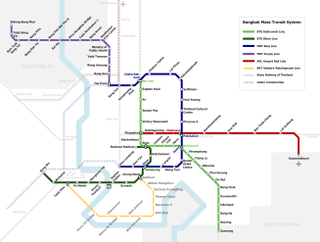
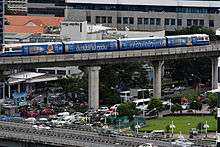

Plans for mass transit in Bangkok began in the early-1980s. An early version of the Skytrain project was known as the Lavalin Skytrain because it was designed using the Vancouver SkyTrain as a model, adopting technology developed by SNC-Lavalin. Due to political interference, the concession with Lavalin was cancelled in June 1992,[4] despite Bangkok's chronic traffic congestion. The Thai Government focused on increasing road and expressway infrastructure in an attempt to reduce the congestion. This had little impact as the number of cars on the road continued to increase dramatically. The routes considered as part of the Skytrain project would become the basis for the MRT system and are mainly underground. In the early-1990s, foundations and a viaduct for the Lavalin Skytrain were constructed in the middle of the Phra Pok Klao Bridge across the Chao Phraya River. The planned metro bridge remains unused but may be part of the MRT's future Purple Line.
Another abortive attempt at building an elevated rail network was the Bangkok Elevated Road and Train System (BERTS), which was terminated in 1998 after only 10 percent had been completed.[5]
Shortly after it became clear that the Lavalin Skytrain had stalled, then-Governor Major General Chamlong Srimuang asked his deputy, Captain Kritsada Arunwong na Ayutthaya, to create a new feeder system with a route along Sukhumvit and Silom Roads. Krisda and his team from the Bangkok Metropolitan Administration (BMA) succeeded in finding a private investor. Krisda also convinced everyone concerned to allow the city supervise the project. Keeree Kanjanapas founded the Bangkok Transit System Corporation (BTSC) and it successfully financed the system and grew it from a feeder system to a full mass transit project. Thanayong Public Company Limited (SET: TYONG,[6] Thai: บริษัท ธนายง จำกัด (มหาชน)) had a 28 percent stake in BTSC when the Skytrain began, and therefore in its early days the system was sometimes referred to as the "Thanayong Skytrain".
Siemens, the supplier of the railway technology, and the Thai contractor, Italian Thai Development, built the system for BTSC. The "Skytrain" name was bestowed later by the press following the Vancouver example where the elevated metro had been named "Skytrain". Originally, the Skytrain depot was to be built underneath Lumphini Park, but due to widespread objections from Bangkok residents it was constructed on a parcel of land on Phahonyothin Road, replacing the old northern/northeastern bus terminal (Mo Chit). The current depot at Mo Chit is part of the proposed "Bangkok Terminal" project, where a large complex composed of a new regional bus terminal, park and ride facility, and other commercial development can be built directly above it.
The Skytrain system was opened on 5 December 1999[7] by Princess Maha Chakri Sirindhorn. It initially had lower-than-predicted ridership, with 200,000 passenger trips per day. Ticket revenue was only enough to meet the trains' operating cost, and not sufficient to service construction loans. The Skytrain's daily passenger numbers have steadily increased since then. On 9 December 2005, more than 500,000 single trips were made on the Skytrain on a single day for the first time. By September 2012, the Skytrain served around 600,000 passengers on an average day, increasing to 650,000 on an average weekday in 2013. A record 760,000 passengers traveled on Sunday, 22 December 2013, a day of mass political protest in Bangkok.[8] The normal Sunday average is 400,000 passengers. The BTS has a fleet of 52 four-car trains (208 carriages). Forty-six new four-car trains (184 carriages) are on order. They will address growing capacity requirements of the existing lines and the full launch of Northern and Southern Green Line extensions. They will be delivered from 2018–2021.[9]:51
Station layout


All of the system's stations are elevated and constructed on three levels.[10] The street level provides access to the station proper via stairs and often escalators. Supporting utility equipment (generators, water tanks) are usually located at this level on traffic islands.
The first elevated level of the stations contains the ticket booths, some small kiosk-like shops, and access control gates. The second level (and third at Siam station) is again accessed with stairs and escalators and contains the platforms and rails. With the exception of Siam Station and Samrong, the stations follow a side platform layout. Siam Station uses island platforms to facilitate cross-platform interchange between the two lines. Additionally, many stations have ramps and elevators to allow passengers who use wheelchairs to access the ticketing hall and platforms from the street. The distances between doors are equal throughout the train, regardless of whether they are in the same or different cars, and the locations where the doors will be after the train has stopped are marked on the platform. The platforms are built to accommodate trains of six cars,[11] but trains of only four cars are in operation. Security personnel are stationed at every platform and ticketing hall.
Three Skytrain stations, Sala Daeng, Asok, and Mo Chit, are interchanges with the underground MRT system. Saphan Taksin station is connected to the adjacent Sathon Pier where the Chao Phraya Express Boat services call.[12] Many stations are linked by skybridges (overhead pedestrian walkways) to neighbouring buildings and public amenities.
Platform screen doors (half size) were installed at On Nut, Phrom Phong, Asok, Chit Lom, Siam, Phaya Thai, Victory Monument, Sala Daeng, and Chong Nonsi stations in 2014.[13] These will eventually be installed at all stations. The installation at Phrom Phrong station caused a software problem and a six-hour shutdown of all BTS services on 24 December 2013, leading to gridlock in the city.[14]
Ticketing
Fares are calculated according to distance.[15] From 2007 a stored-value card called the BTS Smartpass was sold.[16] In May 2012, this was replaced by a new stored-value ticket called Rabbit Card. Rabbit Card is an electronic payment card system that allows holders to pay for the fee of BTS and BRT with only one card.[17] Rabbit Cards can also be used to pay for other services and restaurants that are associated with BTS.[18]
The Mangmoom Card which will be able to be used on the Skytrain, MRT and Airport Rail Link has been repeatedly delayed from its original 2015 launch date[19] and is now expected to launch in late-2018.[20]
Stations and lines
At its opening, the BTS had twenty-three stations on its two lines: seventeen on the Sukhumvit Line and six on the Silom Line, with both lines interchanging at Siam. Since then, five additional stations have opened on the Sukhumvit Line and seven additional stations have opened on the Silom Line.
| Line | Stations | Length [km] |
Length [mi] |
Terminus | Daily ridership |
Began operation | |
|---|---|---|---|---|---|---|---|
| Initial part | Last extension | ||||||
| BTS Sukhumvit Line | 23[21] | 24.02 | 14.93[21] | Mo Chit ↔ Samrong[21] | 1999 | 2017[21] | |
| BTS Silom Line | 13 | 14.67 | 9.12 | National Stadium ↔ Bang Wa | 1999 | 2013 | |
| Together | 35 | 38.69 | 24.04 | 900,000[22] | |||
Route extensions
In 2002, the cabinet of then Prime Minister Thaksin Shinawatra amended a law in order to allow a private firm to finance the cost of operating the train system, while the government would take care of all the civil engineering work.
1st extension, Silom Line, south
On 18 October 2005, with no approval from the central government forthcoming, Bangkok Metropolitan Administration (BMA) decided to fund and complete the 2.2 kilometers (1.4 mi) Silom Line route extension to Krung Thonburi Station (S07) and Wongwian Yai Station (S08). Construction began on 13 December 2005 with completion originally expected within two years. However, problems with the tendering and installation of a new Bombardier open signalling system repeatedly pushed back the schedule. The extension finally opening on 15 May 2009. However, the single platform Saphan Taksin station (originally designed to be only a temporary station) which has only one track has caused repeated delays during rush hour. In 2012, the BMA announced plans to demolish Saphan Taksin station in the future.
2nd extension, Sukhumvit Line, east
A second extension, the 5.25 km On Nut station (E09) to Bearing station (E14) started construction in August 2006.[23] The 4 billion baht extension was again funded by the BMA.[24] The original scheduled opening date was mid-2009. However, an unusual, prolonged delay in the tendering of the contract for the electrical and signals resulted in a two-year delay. "The senior City Hall official responsible for making the purchase has apparently stalled the scheme over fears of being investigated if something went wrong with the purchase."[25]
The BTSC was contracted by the BMA to run the extension. Subsequently, the extension did not open until over two years later on 12 August 2011. The delay in opening prompted the BMA to offer free travel for this extension until the end of 2011 as compensation. A flat fare is charged for this section. The fee for this extension is separate from the distance based fare of the rest of the BTS network.
3rd extension, Silom Line, south
The third extension to the network, a 5.3 km, four station extension from Wongwian Yai (S8) to Bang Wa (S12) in Phasi Charoen District began construction in the 2nd quarter of 2011 with a deadline of the end of 2012. Only the stations had to be constructed as the viaduct had been completed some years prior. However, construction was delayed for many months by the Bangkok floods of late-2011. It eventually opened in stages. Pho Nimit opened on 12 January 2013, Talat Phlu opened on 14 February 2013, with the last two stations opening on 5 December 2013.[26] For most of 2013, passengers changed platforms and trains at Wongwian Yai for a shuttle service to S09 and S10 as there was no turnout at S10 for through trains. Since the opening of the final section of the extension to Bang Wa station on 5 December 2013, this is no longer the case.
4th extension, Sukhumvit Line, east
Construction started in April 2012 for a 12.6 km (7.8 mi), seven station extension from Bearing station (E14) to Samut Prakan Station (E23). The extension is being built by Ch. Karnchang.[27] Two stations (E18 & E22) will be built at a later date. The extension is funded by the MRTA as it is outside BMA city limits. Construction is contracted to take 1,350 days and the extension is planned to open in 2017. In April 2013, the MRTA awarded Ch Karnchang the contract for track laying and electrical systems.[28] As of June 2014, civil works were stated to be 28 percent complete. Construction was completed by 2017, but arguments over who should operate the line delayed the opening. One station, Samrong was opened on 3 April 2017.
Summary of BTS Extensions
- 5 December 1999: Sukhumvit Line: Mo Chit – On Nut; Silom Line: National Stadium – Saphan Taksin
- 15 May 2009: Silom Line: Saphan Taksin (S06) – Wong Wian Yai(S08)
- 12 August 2011: Sukhumvit Line: On Nut (E09) – Bearing (E14)
- 12 January 2013: Silom Line: Wong Wian Yai (S08) – Pho Nimit (S09)[29]
- 14 February 2013: Silom Line: Talat Phlu (S10)
- 5 December 2013: Silom Line: Wuttakat (S11); Bang Wa (S12)
- 3 April 2017: Sukhumvit Line: Samrong (E15)
Under construction
Sukhumvit Line, east
Six stations remain to be opened on the Sukhumvit Line eastern extension, from Pu Chao (E16) to Kheha (E23).
Sukhumvit Line, north
- 1) Mo Chit station to Saphan Mai: 11.4 km, 12 stations (N9–N20).
- 2) Saphan Mai to Khu Khot: 7.5 km, four stations (N21-N24).
A 11.4 km, 12 station northern extension from Mo Chit station to Saphan Mai in Don Mueang District has been planned since the Sukhumvit Line opened. Originally, this extension was scheduled to be completed by 2008. However, due to a combination of changes in government, a prolonged environmental study, and problems with locating a suitable train depot, the extension has been continually delayed.
A further 16.5 km, nine station extension from Saphan Mai to Lam Lukka was also planned once the extension to Saphan Mai had been completed. This was subsequently split into two extensions. A 7.5 km, four station extension to Khu Khot and a 9 km, five station extension along Lam Lukka Road to Lam Lukka.
Due to the significant delay in the northern extension plans, in mid-2013 it was decided by the MRTA to tender extensions (1) & (2) at the same time by the end of 2013. However, the dissolution of parliament in November 2013 delayed this yet again. A tender was finally released in January 2014 [30] with an April deadline before being delayed until late May 2014 due to concerns from bidders.[31]
A military coup in late-May suspended the bidding process while the military administration reviewed all major projects. In late-June, the military administration affirmed the tender which will proceed before the end of 2014. In mid-August, the MRTA announced that the new tender deadline will be 30 September 2014.[32] Five bidders have qualified and successful bids will be announced by December.[33] The contract to construct the line for both extensions (1) & (2) was finally signed in April 2015 with schedule to open in 2020.[34][35]
Future extension plans
Sukhumvit Line, north
A further 9 km, five station extension from Khu Khot station to Lam Lukka station is planned to be constructed by 2029. An MRTA source has stated that the tender for this extension should be issued in 2018 once the terms of reference are finalized.[36]
Sukhumvit Line, east
- A further 7 km, five station extension from Kheha Samut Prakan station to Bang Pu station is planned. It may be tendered in 2018 according to an MRTA source.[37]
- Long terms plans call for a spur line from Bang Na – Suvarnabhumi Airport (terminating at future South Passenger Terminal of Suvarnabhumi Airport). However, this may also be built as a light rail (monorail) line.
Silom Line, south
After the opening of S11 & S12 on 5 December 2013, the BMA announced a new proposal to further extended the Silom Line by 7 km from Bang Wa (S12) station, by six stations to Taling Chan, where it would connect with the SRT Light Red Line.[38]
If approved, the proposed time frame would be for completion of design by 2015. Construction would be undertaken from 2016-2018 for a planned 2019 opening. Part of the basis for this further extension by the BMA is that it would provide proximate access to the Southern Bus Terminal. This proposal is currently under preliminary study by the BMA.
Silom Line, west
The Silom Line is planned to be extended by one or two stations west along Rama 1 from National Stadium (W1) to link with the SRT Dark Red Line at Yot Se station. However, no time frame for this extension has been announced and this section of the Dark Red Line will not be built before 2018.
Originally, the plan was to extend the Silom Line west from National Stadium into Chinatown, then north to Democracy Monument where it would then run west to Rattanakosin Island and Sanum Luang, tunnel under the river to the Thonburi side before terminating at Phran Nok. However, this plan was shelved in 2009 and much of this route has been replaced by routing changes to the planned MRT Orange Line.
BTS Group Holdings will be bidding to manage more BTS and MRT lines in the future through financing built out of its BTS Rail Mass Transit Growth Infrastructure Fund after it got approval from the Thai Securities and Exchange Commission in March 2013. The IPO raised US$2.1 billion, the largest in Thailand's history.[39]
| BTS Skytrain Extension lines | |||||||
|---|---|---|---|---|---|---|---|
| Line | Colour | Date opening | Terminal | Length /km | Number of stations | Status | |
| Sukhumvit Line extension | Light Green | 2018 | Samrong | Kheha S.P. | 12.6 km (7.8 mi) | 6 | Under Construction |
| 2020 | Mo Chit | Khu Khot | 18.9 km (11.7 mi) | 16 | Under Construction | ||
| 2022(?) | Kheha Samut Prakan | Bang Pu | 7 km (4.3 mi) | 4 | Planned | ||
| TBD | Udom Suk | Suvarnabhumi Airport | ?? | 12 | Planned | ||
| 2022(?) | Khu Khot | Eastern Outer Ring | 9 km (5.6 mi) | 4 | Planned | ||
| Silom Line extension | Dark Green | 2020+(?) | National Stadium | Yot Se | 2 km (1.2 mi) | 1-2 | Planned |
| TBD | Bang Wa | Taling Chan | 7 km (4.3 mi) | 6 | Preliminary study | ||
Rolling stock
The BTS Skytrain uses two variations of electric multiple unit rolling stock. All operate on 1,435 mm (4 ft 8 1⁄2 in) standard gauge. All trains have four doors on each side per car, an air-conditioning unit, and LCD monitors for public announcement and advertising. Public announcements are spoken by actress Ratklao Amaradit. The power supply for all trains is at 750 V DC from the third rail.
Siemens train
First order
The rolling stock of BTS Skytrain, in use when the line opened in 1999, consisted of 35 Siemens Modular Metro trains from Siemens. These initial trains had three cars, two motor cars and one trailer in the center. The Sukhumvit Line used 20 trains, and the Silom Line had 15.
After the 12 new car CNR trains were delivered for the Silom line in December 2010, the 15 Siemens trains on the Silom Line were transferred to the Sukhumvit Line.
Second order: extra cars to expand to four-car train operations
To increase capacity, in October 2010, BTSC ordered an extra 35 single cars from Siemens to make each train a four car set.[40][41]
These extra cars were progressively introduced into operation from November 2012 to March 2013, when all 35 sets of Siemens rolling stock finally became four car sets.[42]
The Silom Line cars have been modified to support a signaling system from Bombardier Transportation since the extension from Saphan Taksin to Wong Wian Yai.
Third order: new four-car sets for extension operations
To serve the Sukhumvit Line Extension (East), expected to open in late 2018, BTSC signed an order for 22 new Siemens Inspiro four-car trains with a consortium of Siemens and Bozankaya in May 2016, with planned deliveries in 2018 and 2019.[43]
These trains will be manufactured in the Bozankaya factory in Ankara, Turkey. Siemens will supply bogies, traction, braking and auxiliary systems and be responsible for project management, development, construction and commissioning of the trains. Siemens will also take on service and maintenance for 16 years.
The first set of the new batch of rolling stock arrived in early August 2018 for testing and approval by the BTSC. These new trains increase capacity from 1,490 passengers per train to 1,573.[44][45]
Changchun trains
First order
In early 2008, the BTSC ordered 12 new trains (12 sets of four cars) from Changchun Railway Vehicles (EMU B class) to cater for the then soon to open Wong Wian Yai extension of the Silom Line. Their design was modified to the existing BTS's Siemens Modular Metro. The new trains were delivered late and only began service the Silom Line in December 2010. This was some 18 months after the Wong Wian Yai and Krung Thonburi stations were opened in May 2009 during which time there was severe overcrowding on the Silom line.
These trains consist of two-motor cars and two-trailer cars (i.e., four-car trainsets) and feature LCD TVs for public announcements and advertising. An advanced digital voice announcement (DVA) and passenger information systems was installed.
Second order
In September 2011, the BTSC ordered five more four-car trainsets of CNR rolling stock for 1.5 billion baht to prepare for the Silom Line extension to Bang Wa which was then due to open in December 2012.[46] These five new train sets of rolling stock entered service on 29 November 2013 after the first two stations of the Silom Line extension to Bang Wa opened in January and February 2013, respectively. This second batch of CNR EMUs (B Class) differ slightly from the first batch in exterior fitting out such as with the LCDs screens, LED route displays, signage, and passenger communication units.
Third order
In May 2016, BTSC has signed a contract to order 24 more four-car trains of CRRC Changchun Railway Vehicles rolling stock to prepare for the Sukhumvit Line extension (North) and to cater for increasing demand, with expected delivery in 2018.[43]
Ridership
The first years of operations saw limited ridership. The line had few direct ramps into malls and lacked escalators. Little by little, while escalators were installed and side bridges added, patronage increased. The opening of Siam Paragon Mall in 2004, at the time Thailand's most luxurious mall, boosted crowds at the system's central Siam station. The redevelopment of the Ratchaprasong and Siam districts as well as new "skywalks" fostered growing accessibility. Ridership continued to increase with incremental expansion of the line, from 529,466 weekday passengers in 2011[3] to 573,041 in January 2012,[3] to 668,302 in August 2013, surpassing 600,000 passengers daily for all of August.[47] Nowadays at peak hour, the trains sometimes depart without being able to take all waiting passengers. The total number of passenger trips made between 12 May 1999 and 25 September 2013 was 1,794,280,399.[2] Political unrest in Bangkok in December 2013 led to an all-time high Sunday ridership of 760,000, while the subway also hit record highs.[48] By December 2017, nearly 900,000 passengers were using the BTS system daily.[49]
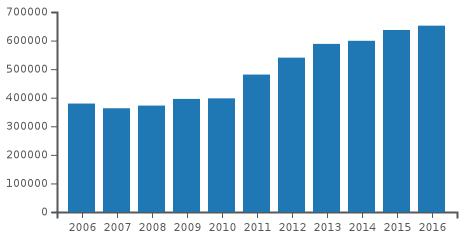 |
| Average daily ridership on the BTS Skytrain 2006-2015.[50] |
Ridership statistics
| Year[51] | Total ridership | Average daily ridership |
|---|---|---|
| 1999 | 4,585,743 | 169,842 |
| 2000 | 55,092,671 | 150,469 |
| 2001 | 74,025,652 | 202,685 |
| 2002 | 93,493,981 | 256,033 |
| 2003 | 102,348,697 | 280,379 |
| 2004 | 115,681,448 | 316,068 |
| 2005 | 127,350,084 | 348,795 |
| 2006 | 140,048,849 | 383,635 |
| 2007 | 132,070,502 | 361,977 |
| 2008 | 136,350,007 | 372,551 |
| 2009 | 140,957,969 | 386,145 |
| 2010 | 143,102,971 | 392,376 |
| 2011 | 167,348,070 | 458,275 |
| 2012 | 194,113,068 | 530,422 |
| 2013 | 208,764,971 | 571,855 |
| 2014 | 219,422,367 | 598,984 |
| 2015 | 229,853,593 | 629,218 |
| 2016 | 237,047,435 | 647,752 |
| 2017 (Jan - Nov) | 220,714,556 | 657,909 |
| Riders [52] | ||
|---|---|---|
| No. | Station | Number (People per day) |
| 1 | Siam | 112,600 |
| 2 | Asok | 85,100 |
| 3 | Mo Chit | 79,500 |
| 4 | Victory Monument | 79,000 |
| 5 | Sala Daeng | 52,900 |
| 6 | On Nut | 52,600 |
| 7 | Chit Lom | 47,300 |
| 8 | Phaya Thai | 42,800 |
| 9 | Bearing | 41,400 |
| 10 | Phrom Phong | 39,600 |
See also
- Sukhumvit Line
- Silom Line
- Keeree Kanjanapas
- Rail transport in Bangkok
- List of rapid transit stations in Bangkok
- List of rapid transit systems
- SRT Red Lines
- Bangkok BRT
- Mass Rapid Transit Master Plan in Bangkok Metropolitan Region
- Bangkok Metro
- MRT Blue Line
- MRT Brown Line
- MRT Grey Line
- MRT Light Blue Line
- MRT Orange Line
- MRT Pink Line
- MRT Yellow Line
- SRT Red Lines
References
- 1 2 3 "BTS SkyTrain System - Structure of Routes and Stations". Bangkok Mass Transit System Public Company Limited. Retrieved 2014-06-26.
- 1 2 3 "Current Service Routes". Bangkok Mass Transit System Public Company Limited. December 2013. Retrieved 2014-06-26.
- 1 2 3 "BTS Group Holdings". The Nation. www.nationmultimedia.com. 17 February 2012. Retrieved 2014-06-26.
- ↑ Unger, Danny (1998-09-28). Building Social Capital in Thailand: Fibers, Finance and Infrastructure. Cambridge University Press. ISBN 9780521639316.
- ↑ Tribune, Thomas Crampton (1998-10-14). "Thais Revisit a Troubled Mass-Transit Project". The New York Times. ISSN 0362-4331. Retrieved 2016-12-04.
- ↑ "Our History". BTS Group Holdings Public Company Limited. Retrieved 2014-06-26.
- ↑ Mydans, Seth (1999-12-06). "Bangkok Opens Skytrain, but Will It Ease Car Traffic?". The New York Times. ISSN 0362-4331. Retrieved 2016-12-04.
- ↑ 'Trains gain as rallies clog roads', Bangkok Post, 26 December 2013
- ↑ BTS Group Holdings Annual Report 2017/18 (PDF). Bangkok: BTS Group Holdings PCL. 2018. Retrieved 28 July 2018.
- ↑ "Structure of Routes and Stations". Bangkok Mass Transit System Public Company Limited. Retrieved 2014-06-26.
- ↑ UK, DVV Media. "Skytrain takes off with a bang". Railway Gazette. Retrieved 2016-12-04.
- ↑ "Explore Bangkok by BTS : BTSC". www.bts.co.th. Retrieved 2016-12-04.
- ↑ "BTS stations to get platform doors". Bangkok Post. 17 September 2012. Retrieved 2012-09-17.
- ↑ "Commuters caught in chaos after Skytrain shuts down in morning". The Nation. Bangkok. 25 December 2013.
- ↑ "Ticket Info : BTSC". www.bts.co.th. Retrieved 2016-12-04.
- ↑ "Ticket Info : BTSC". www.bts.co.th. Retrieved 2016-12-04.
- ↑ "What is Rabbit". Bangkok Smartcard System Company Limited (BSS). Retrieved 2014-06-26.
- ↑ "BTS Rabbit Cards". Bangkok BTS. Retrieved 2014-06-26.
- ↑ Mahitthirook, Amornrat (19 February 2012). "One-ticket system for BTS and MRT expected by 2015". Bangkok Post. Retrieved 2012-11-29.
- ↑ "'Spider' cards to crawl out from next June". Bangkok Post. Retrieved 2018-01-12.
- 1 2 3 4 ฐานเศรษฐกิจ (14 July 2016). "BTSสายสีเขียว เชื่อมแบริ่ง -สมุทรปราการ". Retrieved 25 November 2016.
- ↑ ฐานเศรษฐกิจ (17 May 2016). "BTSเทหมื่นล้านซื้อรถไฟฟ้าล็อตใหญ่ ชี้ผู้โดยสารทะลุ9แสนเที่ยวคน/วัน". Retrieved 25 November 2016.
- ↑ Groundbreaking starts on new BTS extension, Dailynews, 15 August 2006
- ↑ BTS extension budget cut, Bangkok Post, 15 December 2006
- ↑ Skytrain link tests delayed, Bangkok Post, 19 September 2009
- ↑ "BTS Skytrain starts it's new station Pho Nimit today and comimg more near to metro park sathorn". metroparksathorn.com. 12 January 2013. Archived from the original on 1 January 2014. Retrieved 2014-06-26.
- ↑ "Ch. Karnchang wins Green Line bid". Bangkok Post. 14 November 2012. Retrieved 2012-11-15.
- ↑ "Ch Karnchang gets Phase 2 of Bearing-Samut Prakan route" The Nation, 13 April 2013
- ↑ "Sukhumbhand woos commuters". The Nation. www.nationmultimedia.com. 16 January 2013. Retrieved 2014-06-26.
- ↑ http://www.mrta.co.th/sysRegister/register131217/proc17122556.pdf
- ↑ http://www.prachachat.net/news_detail.php?newsid=1401076541 "รฟม.ปรับทีโออาร์หมอชิต-คูคต กลางปี59 เปิดให้บริการสายสีม่วง" Prachachat News, 26 May 2014
- ↑ (มหาชน), บริษัท มติชน จำกัด. "รฟม.เร่งยิกประมูลรถไฟฟ้าสายสีเขียว "หมอชิต-คูคต" 2.9 หมื่นล้าน ดีเดย์ 30 ก.ย. เปิดยื่นซองราคา". Retrieved 25 November 2016.
- ↑ (มหาชน), บริษัท มติชน จำกัด. "5กลุ่มบริษัทผ่านคุณสมบัติสร้างรถไฟสีเขียว คาดหาผู้รับเหมาได้ไม่เกินต้นปี58". Retrieved 25 November 2016.
- ↑ สร้างรถไฟฟ้าไปคูคตเซ็นสัญญาวันนี้ลงพื้นที่กลางปี, Dailynews, 3 April 2015
- ↑ Bangkok Sukhumvit Line extension contracts, Railway Gazette, 13 April 2015
- ↑ "MRTA pushes to fast-track launch of South Green Line". The Bangkok Post. Bangkok. 1 December 2017. Retrieved 15 December 2017.
- ↑ "MRTA pushes to fast-track launch of South Green Line". The Bangkok Post. Bangkok. 1 December 2017. Retrieved 15 December 2017.
- ↑ "เปิดฟรี 1 เดือน บริการรถไฟฟ้า ตากสิน-บางหว้า". Retrieved 25 November 2016.
- ↑ Maierbrugger, Arno (17 March 2013). "Thailand's largest ever IPO a done deal". Inside Investor. Retrieved 2013-03-18.
- ↑ "Bangkok's Skytrain increases train fleet". International Railway Journal. 11 October 2010. Retrieved 2014-08-08.
- ↑ Wiriyapong, Nareerat (29 August 2012). "Sukhumvit BTS line to get four-car trains in October". Bangkok Post. Retrieved 2012-11-29.
- ↑ "News & Events - BTS takes delivery of new train cars from SIEMENS". BTS Group Holdings Public Company Limited. 18 July 2012. Retrieved 2014-08-08.
- 1 2 Siemens and CRRC trains for Bangkok Metro Report International 20 May 2016
- ↑ "First of new BTS trains to undergo testing". The Bangkok Post. 7 August 2018.
- ↑ Siemens and Bozankaya roll out Bangkok Skytrain vehicle Metro Report International 19 June 2018
- ↑ "More 4-car trains on BTS shopping list". The Bangkok Post. 29 September 2011. Retrieved 2014-08-08.
- ↑ "Skytrain passengers hit 600,000 in August". The Nation. www.nationmultimedia.com. 19 September 2013. Retrieved 2014-06-26.
- ↑ "Trains gain as rallies clog roads". Bangkok Post. 26 December 2013. Retrieved 2014-06-26.
- ↑ "Skytrain boss warns rail fares will rise". Bangkok Post. 15 December 2015. Retrieved 2017-12-15.
- ↑ "BTS Group Holdings PCL Ltd Annual Report 2015/6" (PDF).
- ↑ "BTS Group Holdings Public Company Limited". bts.listedcompany.com. Retrieved 2017-05-31.
- ↑ "10 สถานีบีทีเอส ยอดผู้ใช้บริการสูงสุด" [10 stations BTS riders to the maximum]. ประชาชาติธุรกิจ [Nation] (in Thai). Retrieved 2014-06-26.
External links
| Wikimedia Commons has media related to BTS Skytrain. |
